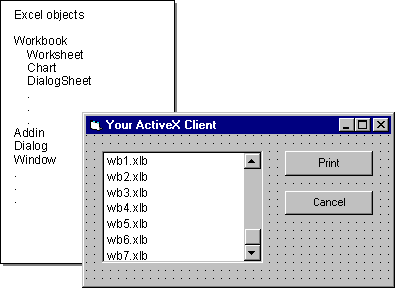
Exposing objects provides a way to manipulate an application's tools programmatically. This allows customers to use a programming tool that automates repetitive tasks that might not have been anticipated.
For example, Microsoft® Excel® exposes a variety of objects that can be used to build applications. One such object is the Workbook, which contains a group of related worksheets, charts, and macros — the Microsoft Excel equivalent of a three-ring binder. Using Automation, you could write an application that accesses Microsoft Excel Workbook objects, possibly to print them, as in the following diagram:

With Automation, solution providers can use your general-purpose objects to build applications that target a specific task. For example, you could use a general-purpose drawing tool to expose objects that draw boxes, lines, and arrows, insert text, and so forth. Another programmer could build a flowchart tool by accessing the exposed objects and then adding a user interface and other application-specific features.
Exposing objects to Automation or supporting Automation within a macro language offers several benefits.